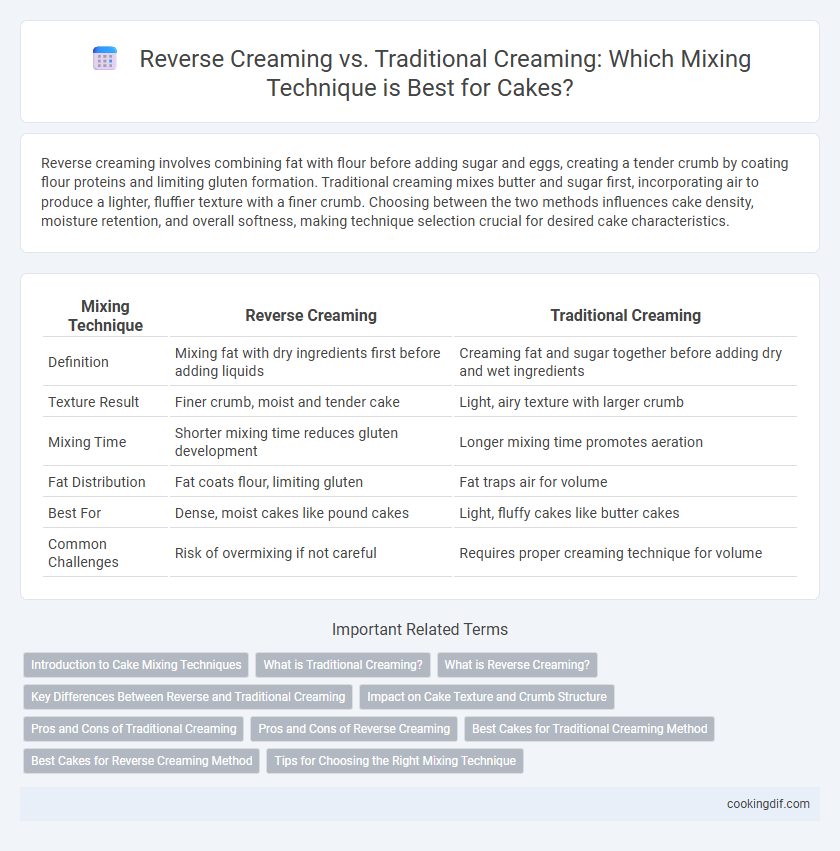Reverse creaming involves combining fat with flour before adding sugar and eggs, creating a tender crumb by coating flour proteins and limiting gluten formation. Traditional creaming mixes butter and sugar first, incorporating air to produce a lighter, fluffier texture with a finer crumb. Choosing between the two methods influences cake density, moisture retention, and overall softness, making technique selection crucial for desired cake characteristics.
Table of Comparison
| Mixing Technique | Reverse Creaming | Traditional Creaming |
|---|---|---|
| Definition | Mixing fat with dry ingredients first before adding liquids | Creaming fat and sugar together before adding dry and wet ingredients |
| Texture Result | Finer crumb, moist and tender cake | Light, airy texture with larger crumb |
| Mixing Time | Shorter mixing time reduces gluten development | Longer mixing time promotes aeration |
| Fat Distribution | Fat coats flour, limiting gluten | Fat traps air for volume |
| Best For | Dense, moist cakes like pound cakes | Light, fluffy cakes like butter cakes |
| Common Challenges | Risk of overmixing if not careful | Requires proper creaming technique for volume |
Introduction to Cake Mixing Techniques
Reverse creaming involves mixing fat with dry ingredients before adding liquids, which creates a tender crumb by coating flour proteins and limiting gluten development. Traditional creaming blends butter and sugar first to incorporate air, producing a lighter, fluffier texture ideal for sponge cakes. Both techniques affect cake structure, moisture, and crumb, with reverse creaming favored for dense, moist cakes and traditional creaming for airy, delicate results.
What is Traditional Creaming?
Traditional creaming is a cake mixing technique where butter and sugar are beaten together until light and fluffy, incorporating air to create a tender and airy crumb. This method is essential for many classic cake recipes, as it provides structure and volume by evenly distributing fat and sugar throughout the batter. Bakers often use an electric mixer to achieve the desired consistency, ensuring a smooth base for adding eggs and dry ingredients.
What is Reverse Creaming?
Reverse creaming is a cake mixing technique where fat is first combined with dry ingredients before adding liquids, unlike traditional creaming that starts by beating butter and sugar together. This method creates a tender crumb by coating flour proteins with fat, reducing gluten formation and resulting in a finer, softer texture. Bakers often use reverse creaming for delicate cakes like pound cakes and butter cakes to achieve a moist and uniform crumb structure.
Key Differences Between Reverse and Traditional Creaming
Reverse creaming involves mixing fat and flour first to coat the flour particles, resulting in a finer crumb and denser texture, while traditional creaming beats fat and sugar to incorporate air for a lighter, fluffier cake. The reverse method reduces gluten development, making it ideal for tender cakes like pound cakes, whereas traditional creaming promotes volume, common in layer cakes and cupcakes. Understanding these key differences allows bakers to select the optimal technique based on desired cake texture and structure.
Impact on Cake Texture and Crumb Structure
Reverse creaming, where fat is mixed with flour before adding liquids, produces a finer crumb and denser texture by coating flour particles and limiting gluten formation, ideal for tender cakes like pound cakes. Traditional creaming incorporates butter and sugar first, trapping air to create a lighter, airier crumb and a softer texture, preferred in delicate cakes such as sponge or butter cakes. The choice between reverse and traditional creaming directly affects cake density, crumb tightness, and overall mouthfeel, making the technique crucial for desired cake outcomes.
Pros and Cons of Traditional Creaming
Traditional creaming involves beating butter and sugar together until light and fluffy, which incorporates air and provides a tender crumb and increased volume in cakes. This method can result in a more consistent texture and better rise but requires room temperature butter for optimal aeration, making it less suitable for quick preparation. However, improper creaming or overmixing can cause dense or tough cakes due to gluten overdevelopment or air bubble collapse.
Pros and Cons of Reverse Creaming
Reverse creaming, a mixing technique where flour is combined with fat before adding sugar and eggs, creates a tender cake crumb by coating the flour particles and limiting gluten development. This method results in better cake structure, reduced doming, and a finer, more even crumb compared to traditional creaming. However, reverse creaming can be less forgiving with mixing times, risking a dense texture if overmixed, and it may not produce the same rise or volume as the traditional method.
Best Cakes for Traditional Creaming Method
The traditional creaming method excels in producing cakes with a tender crumb and light texture, particularly for classic butter cakes like pound cakes and sponge cakes. This technique effectively incorporates air by beating butter and sugar together, which enhances leavening and results in a consistent rise. Recipes with higher fat content benefit most from traditional creaming, yielding moist and fluffy cakes with a fine crumb structure.
Best Cakes for Reverse Creaming Method
The Reverse Creaming Method creates tender, dense cakes by coating flour with fat before adding sugar and liquids, reducing gluten development and producing a fine crumb ideal for pound cakes, butter cakes, and dense chocolate cakes. This technique excels with recipes requiring a moist texture and tight structure, such as yellow cakes and carrot cakes. Traditional Creaming introduces air for lighter textures, making Reverse Creaming preferable for richer, more compact cake varieties.
Tips for Choosing the Right Mixing Technique
Selecting the appropriate mixing technique depends on desired cake texture and ingredient composition; reverse creaming produces tender, fine-crumb cakes by coating flour with fat before liquids, reducing gluten formation. Traditional creaming incorporates air by beating butter and sugar first, resulting in lighter, fluffier cakes ideal for sponges and butter cakes. Assess moisture content, fat type, and final crumb preference to determine whether reverse or traditional creaming best suits the recipe.
Reverse Creaming vs Traditional Creaming for mixing technique Infographic

 cookingdif.com
cookingdif.com